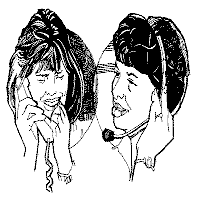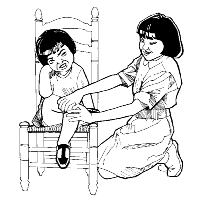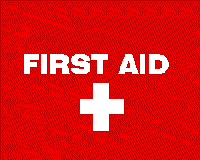| EMERGENCY ILLNESS AND
INJURY PROCEDURES
When parents
enroll their child, they should provide you with the contact information
and consent that you will need if there is an emergency involving that
child. A sample "Child Care Emergency Contact Information and Consent
Form" is included in this section. The form includes a statement
of parental consent for you to administer first aid and get emergency
services for their child. You should request that parents update this
form at least once every year.
All parents
of children in your care should know your emergency procedures. Let parents
know that you are trained in first aid and CPR as taught by the American
Red Cross or any other nationally approved first aid training facility.
Tell parents how often you take refresher courses. Tell them that in the
event of an emergency, you will:
- quickly
assess the child's health,
- call 911
or other appropriate emergency help as needed,
- give first
aid and CPR, if necessary, and
- then contact
them or the person they have listed to call in an emergency.
|
CHILD CARE EMERGENCY CONTACT INFORMATION AND
CONSENT FORM
Child's Name:__________________________________ Birth date: _____________________________
Parent/Guardian #1 Name: ________________________________________________________________
Telephone: Home_________________ Work____________________
Beeper/Car________________
Parent/Guardian #2 Name:_________________________________________________________________
Telephone: Home_________________ Work____________________
Beeper/Car________________
EMERGENCY CONTACTS (to whom child may be released if guardian is
unavailable)
Name #1:___________________________________________Relationship__________________________
Telephone: Home_________________ Work____________________ Beeper/Car_________________
Name #2:___________________________________________ Relationship__________________________
Telephone: Home_________________ Work____________________ Beeper/Car__________________
CHILD'S PREFERRED SOURCES OF MEDICAL CARE
Physician's Name:_______________________________________________________________________
Address:______________________________________________________Telephone:________________
Dentist's Name:_________________________________________________________________________
Address:______________________________________________________Telephone:________________
Hospital Name:__________________________________________________________________________
Address:______________________________________________________Telephone____________________
Ambulance Service:_______________________________________________________________________
Telephone:____________________________
(Parents are responsible for all emergency transportation charges.)
CHILD'S HEALTH INSURANCE
Insurance Plan:__________________________________________________
ID#_____________________
Subscriber's Name (on insurance card):______________________________________________________
SPECIAL CONDITIONS, DISABILITIES, ALLERGIES, OR MEDICAL EMERGENCY
INFORMATION
_________________________________________________________________________________________
_________________________________________________________________________________________
- PARENT/GUARDIAN CONSENT AND AGREEMENT FOR EMERGENCIES
- As parent/guardian, I consent to have my child receive first
aid by facility staff and, if necessary, be transported to receive
emergency care. I will be responsible for all charges not covered
by insurance. I give consent for the emergency contact person
listed above to act on my behalf until I am available. I agree
to review and update this information whenever a change occurs
and at least every 6 months.
Parent/Guardian Signature_____________________________________________
Date_________________
Parent/Guardian Signature_____________________________________________
Date_________________
|
Return
At all times,
you should:

- Have emergency
numbers posted by the phone--police, ambulance (911), and poison control
center. (A list of regional poison control centers is included in this
handbook as Appendix 2.)
- Keep parents’
consent forms for emergency treatment and numbers for emergency contacts
on file. (See sample on next page.)
- Take pediatric
CPR and first aid training every year to maintain your American Red
Cross certification.
- Post first
aid procedures where they can be easily seen. You may want to copy and
laminate the list of first aid measures included in this chapter.
- Write
up an emergency procedure and evacuation route and make sure you are
familiar with it.
- Keep a
fully stocked first aid kit in easy reach of all providers, but out
of reach of children. Check the first aid kit regularly and restock
it as necessary. (See box for what your kit should contain.)
- In addition
to the supplies listed for your first aid kit, you should also keep
ice cubes or ice bags in the freezer to use to reduce swelling of some
injuries.
- Place
a stocked first aid kit in every vehicle used to transport the children.
In addition to the items in your facility first aid kit, your vehicle
kit should also include a bottle of water, soap, coins for a pay telephone,
and a first aid guide.
- Don't
use first aid sprays and ointments. They may cause allergic reactions
or skin damage. Use alcohol or antiseptic wipes.
- Wear gloves
if you might come in contact with blood.
- Have first
aid supplies handy on the playground by keeping a zip-lock plastic bag
stocked with disposable gloves, sterile wipes, gauze wrap, and bandaids
in your pocket.
|
What
Your First Aid Kit Should Include
- Box
of nonporous disposable gloves
- Sealed
packages of alcohol wipes or antiseptic
- Small
Scissors
- Tweezers
(for removing splinters)
- Thermometer
- Adhesive
bandage tape
- Sterile
gauze squares (2" and 3")
- Triangular
bandages
- Flexible
roller gauze (1" and 2" widths)
- Triangular
bandages
- Safety
pins
- Eye
dressing
- Insect
sting preparation
- Pencil
and notepad
- Syrup
of ipecac
- Cold
pack
- Small
splints
- Sealable
plastic bags for soiled materials
|
Return

If an injury
occurs:
- Stay calm.
- Check
for life-threatening situations (choking, severe bleeding, or shock).
Do not move a seriously injured child.
- Call 911
or your local emergency number if the child is seriously hurt.
- Give CPR
or first aid, if necessary.
- Contact
the parent/emergency contact.
- Record
all injuries on a standard form developed for that purpose. The form
below is an example of a standard injury report form. You may want to
list on the back of the form the names of all of those who witnessed
the injury.
|
INJURY
REPORT FORM
Date
of Injury: ___________
Time of Injury: __________ _am _pm
Name of Injured____________________________
Sex: __Male __Female
Age: ___ years
Where
injury happened: ______________________
_________________________________________
How
injury happened: _______________________
_________________________________________
_________________________________________
_________________________________________
Part
of body injured: _________________________
Objects
involved (if any): _____________________
What
was done to help the injured: ______________
_________________________________________
_________________________________________
Parent/Guardian
advised:
of injury: _yes _no
to seek medical attention: _yes _no
Supervisor
(at time of injury):_________________
Person completing form: _________________
Date form completed: _________________
|
Return
Measures
|

First Aid Measures
Note: Wear disposable gloves if coming in contact with
blood.
Dispose of gloves in a sturdy leakproof plastic bag. Wash
hands.
|
| Condition |
Action |
 |
Abdominal Pain
(Severe) |
Notify parents.
If the child has been injured and has severe or bloody vomiting
and is very pale, call 911.
Do not allow child to eat or drink. |
 |
Abrasions
(Scrapes) |
Wash abrasion with soap and water.
Allow to dry.
Cover with a sterile nonstick bandaid or dressing.
Notify parents. |
 |
Asphyxiation
(Suffocation) |
Call 911.
If the child is in a closed area filled with toxic fumes, move
the child outside into the fresh air.
Perform CPR if child is not breathing. |
 |
| Asthma Attack |
Give prescribed medication, if any, as previously agreed
to by parents. If attack does not stop after the child is given
the medication, and the child is still having difficulty breathing,
call 911.
If you have no medication and the attack does not subside
within a few minutes, call the parents and ask them to come
immediately and take the child for medical care.
If the child has difficulty breathing, call 911. |
 |
| Bites and Stings |
| Animal: |
Wash the wound with soap and water.
Notify parents to pick up the child and seek medical advice.
If bite is from a bat, fox, raccoon, skunk, or unprovoked cat
or dog, or any animal that may have rabies, call the health
department, which will contact animal control to catch the animal
and observe it for rabies. Do not try to capture the animal
yourself. Make note of the description of the animal and any
identifying characteristics (whether dog or cat had a collar,
for example). |
| Human: |
Wash the wound with soap and water.
Notify parents.
If bite causes bleeding, contact the health department for advice. |
| Insect: |
Do not pull out stinger as it may break off; remove the stinger
by scraping it out with a fingernail or credit card, then apply
a cold cloth.
Notify parents. Call 911 if hives, paleness, weakness,
nausea, vomiting, difficult breathing, or collapse occurs. |
| Snake: |
Call local poison control center. Do not apply ice.
Notify parents immediately, then the health department.
If the child has difficulty breathing, call 911. |
| Ticks: |
Notify parents to seek preferences. If parents approve, try
to remove tick with tweezers. |
| Waterlife: |
For stingray or catfish stings, submerge affected area in
warm water to deactivate the toxin. For other stings, such as
from jellyfish, rinse with clean water. Call parents to seek
medical care. |
 |
| Bleeding |
| External: |
For small wounds, apply direct pressure with a gauze pad for
10-15 minutes. (Use gloves.)
If bleeding continues or is serious, apply a large pressure
dressing and call 911 immediately. |
| Internal: |
If child has been injured and vomits a large amount of blood
or passes blood through the rectum, call 911. Otherwise,
contact parents to seek medical care.
If a child is a hemophiliac and has injured a joint through
a minor bump or fall, call the parents. The child may need an
injection of blood factor. |
 |
| Bruises |
Apply cold compresses to fresh bruises for the first 15 to
30 minutes.
Note: A child with bruises in unusual locations should be
evaluated for child abuse. |
 |
| Burns and Scalds |
| No blisters: |
Place burned extremity in cold water or cover burned area
with cold, wet cloths until pain stops (at least 15 minutes). |
| With blisters: |
Same as for no blisters. Do not break blisters. Call parents
to take child to get medical care. |
Deep, extensive
burns: |
Call 911.
Do not apply cold water.
Cover child with a clean sheet and then a blanket to keep the
child warm. |
| Electrical: |
If possible, disconnect power by shutting off wall switch,
throwing a breaker in the electrical box, or any other safe
way.
Do not directly touch child if power is still on. Use wood or
thick dry cloth (nonconducting material) to pull child from
power source.
Call 911.
Start CPR if necessary.
Notify parents.
Note: A child with burns and scalds should be evaluated for
child abuse. |
 |
| Croup and Epiglottitis |
| Croup: |
Call parents to pick up child and get medical care. |
| Epiglottitis: |
(Similar to croup, but with high fever, severe sore throat,
drooling, and difficulty breathing):
Transport child in upright position to medical care.
Call 911 for ambulance if child has severe breathing
difficulty. |
 |
| Dental Injuries |
| Braces (Broken) |
Remove appliance, if it can be done easily.
If not, cover sharp or protruding portion with cotton balls,
gauze, or chewing gum.
If a wire is stuck in gums, cheek, or tongue, DO NOT remove
it.
Call parent to pick up and take the child to the orthodontist
immediately.
If the appliance is not injuring the child, no immediate emergency
attention is needed. |
Cheek, Lip,
Tongue (Cut/
Bitten) |
Apply ice to bruised areas.
If bleeding, apply firm but gentle pressure with a clean gauze
or cloth.
If bleeding continues after 15 minutes, call the parent to pick
up the child and get medical care. |
| Jaw Injury |
Immobilize jaw by having child bite teeth together.
Wrap a towel, necktie, or handkerchief around child's head under
the chin.
Call parent to pick up and take the child to the emergency room. |
| Tooth (Broken) |
Rinse dirt from the injured area with warm water.
Place cold compresses over the face in the area of the injury.
Locate and save any tooth fragments.
Call the parent to pick up and take the child and tooth fragments
to the dentist IMMEDIATELY. |
Tooth (Knocked
Out) |
Find the tooth. Handle tooth by the smooth, white portion
(crown), not by the root. Rinse the tooth with water, but DO
NOT clean it.
Place tooth in a cup of milk or water.
Call the parent to pick up and take the child and tooth to the
dentist IMMEDIATELY. (Time is critical.) |
Tooth (Bleeding
Due to Loss of
Baby Tooth) |
Fold and pack clean gauze or cloth over bleeding area.
Have child bite on gauze for 15 minutes.
Repeat again. If bleeding persists, call parent to pick up and
take the child to the dentist. |
Sores (Cold/
Canker) |
Tell parent and request physician examination if sore persists
for more than a week. |
 |
| Eye Injuries |
If a chemical is splashed in the eye, immediately flush eye
with tepid water, with the eyelid held open. Then remove contact
lens, if present, and rinse eye with tepid water for at least
15 minutes.
Do not press on injured eye.
Gently bandage both eyes shut to reduce eye movement.
Call parent to pick up and take child to get medical care.
|
 |
| Fractures |
Arm, Leg,
Hand, Foot,
Fingers, Toes |
Do not move injured part if swollen, broken, or painful.
Call parent to pick up and take child to get medical care. |
| Neck or Back |
Do not move child; keep child still.
Call 911 for ambulance. |
 |
| Frostbite/Freezing |
Warm arm, leg, hand, foot, fingers, or toes by holding them
in your armpit.
Warm ears and noses with a warm palm.
For deeper freezing, hold extremity in warm water (105°-110°
F) for 20 minutes.
Protect involved area from further damage.
Apply a sterile gauze and elevate injured area for 40 minutes.
Call parents to pick up and take child to get medical care.
If child is lethargic, call 911. |
 |
| Frozen to Metal |
Do not allow child to pull away from metal.
Blow hot breath onto the stuck area or pour warm (not
hot) water onto the object.
Gently release child.
If bleeding occurs, such as on the tongue, grasp tongue with
folded sterile gauze and apply direct pressure. Call parents
to pick up and take child to get medical care. |
 |
| Head Injuries |
Keep child lying down.
Call parents
Call 911 if the child is:
- complaining of severe or persistent headache
- less than 1 year old
- oozing blood or fluid from ears or nose
- twitching or convulsing
- unable to move any body part
- unconscious or drowsy
- vomiting
|
 |
| Nosebleeds |
Have child sit up and lean forward.
Loosen tight clothing around neck.
Pinch lower end of nose close to nostrils (not on bony part
of nose). |
 |
| Poisons |
Immediately, BEFORE YOU DO ANYTHING, call the local poison
control center, hospital emergency room, or physician. (A
list of regional poison control centers is included as Appendix
2.)
Call parents.
If child needs to go to for medical evaluation, bring samples
of what was ingested. Bring with you all containers, labels,
boxes, and package inserts that came with the material that
the child took in. Look carefully for extra containers around
the immediate area where the incident occurred. Try to estimate
the total amount of material the child might have taken in,
and whether the material was swallowed, inhaled, injected, or
spilled in the eyes or on the skin. If possible, also bring
with you the child’s health file, including consent forms
and names and telephone numbers of parents/guardians.
Do not make a child vomit if:
- the child is unconscious or sleepy,
- the child has swallowed a corrosive product (acid/drain
cleaner/oven cleaner), or
- the child has swallowed a petroleum product (furniture
polish/kerosene/gasoline).
If instructed by the poison control center to make the child
vomit:
- Use ipecac syrup:
- Children 1 year to 10 years old:
- 1 tablespoon or 3 teaspoons of ipecac and 4 to 8 ounces
of water
- Children over 10 years old:
- 2 tablespoons of ipecac and 4 to 8 ounces of water
- Follow with another 4 to 8 ounces of water.
- Repeat dose ONCE if child has not vomited in 20 minutes.
|
| If a chemical is spilled on someone, dilute it
with water and remove any contaminated clothing, using gloves
if possible. Place all contaminated clothing and other items
in an airtight bag and label the bag. If the chemical has been
splashed int he eye, flush immediately with tepid water and
follow instructions listed above for “Eye Injuries.”
Some poisons have delayed effects, causing moderate or severe
illness many hours or even some days after the child takes
the poison. Ask whether the child will need to be observed
afterward and for how long. Make sure the child’s parents/guardians
understand the instructions.
|
 |
| Seizures |
Remain calm.
Protect child from injury.
Lie child on his or her side with the head lower than the hips,
or on his or her stomach.
Loosen clothing.
Do not put anything in the child's mouth.
Call 911 if seizure lasts more than 5 minutes or if they
are the result of a head injury.
Notify parents. |
 |
|
Return
|